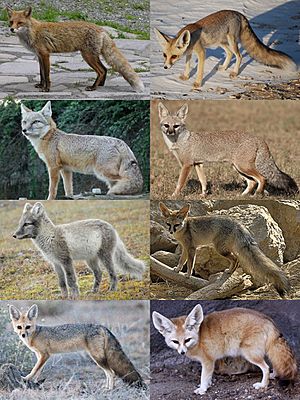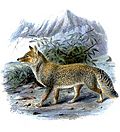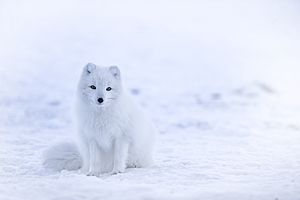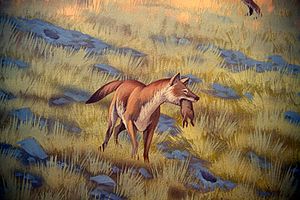Vulpes facts for kids
Quick facts for kids VulpesTemporal range:
7 million years ago to present |
|
|---|---|
 |
|
| Various true foxes: left to right, then top to bottom: red fox, Rüppell's fox, corsac fox, Bengal fox, Arctic fox, Blanford's fox, Cape fox, and fennec fox | |
| Scientific classification |
|
| Kingdom: | Animalia |
| Phylum: | Chordata |
| Class: | Mammalia |
| Order: | Carnivora |
| Family: | Canidae |
| Subfamily: | Caninae |
| Tribe: | Vulpini |
| Genus: | Vulpes Frisch, 1775 |
| Type species | |
| Vulpes vulpes (Linnaeus, 1758)
|
|
| Species | |
Vulpes is a group of animals known as true foxes. They are part of the subfamily called Caninae. This means they are closely related. The word "fox" is often used in their common names.
True foxes are different from other animals in the Canis group, like dogs, wolves, jackals, and coyotes. True foxes are smaller, usually weighing between 5 and 11 kilograms (11-24 pounds). They have a longer, bushier tail and a flatter head. You can often spot them by the black, triangle-shaped marks between their eyes and nose. The tip of their tail is also often a different color from the rest of their fur. Most true foxes live for about two to four years, but some can live up to ten years.
Contents
Meet the True Fox Species
There are 12 different types of true foxes alive today. Here's a look at them:
| Image | Scientific Name | Common Name | Where They Live | Map |
|---|---|---|---|---|
 |
V. bengalensis | Bengal fox | These foxes live only in the Indian subcontinent. |  |
 |
V. cana | Blanford's fox | Blanford's foxes live in parts of the Middle East, like Iran, Israel, Afghanistan, Egypt, and Pakistan. They like dry or semi-dry areas. |  |
 |
V. chama | Cape fox | The Cape fox is found only in Southern Africa, including Zimbabwe, Botswana, and South Africa. They do well in dry grasslands. |  |
 |
V. corsac | Corsac fox | Corsac foxes live in Central Asia. They prefer semi-dry deserts, similar to the Cape and Blanford's foxes. |  |
 |
V. ferrilata | Tibetan sand fox | As its name suggests, the Tibetan sand fox lives in the Tibetan and Ladakh plateau. This includes parts of Nepal, China, India, and Bhutan. They can live at very high altitudes, up to 5300 meters (17,400 feet). |  |
 |
V. lagopus | Arctic fox | Arctic foxes live all around the Arctic Circle. This includes Russia, Svalbard, Iceland, Scandinavia, Finland, Greenland, Northern Canada, and Alaska. |  |
 |
V. macrotis | Kit fox | Kit foxes live in dry areas of North America. They are found in Oregon, Colorado, Nevada, Utah, California, New Mexico, and Texas, as well as in Mexico. |  |
 |
V. pallida | Pale fox | The pale fox lives in the Sahel region of Africa. It also prefers dry areas. |  |
 |
V. rueppellii | Rüppell's fox | Rüppell's foxes are found in North Africa and parts of the Middle East. |  |
 |
V. velox | Swift fox | The swift fox lives in the western grasslands of North America. You can find them in Montana, Wyoming, New Mexico, Colorado, Kansas, Oklahoma, and Texas, plus some parts of Canada. |  |
 |
V. vulpes | Red fox, silver fox and cross fox | The red fox is the most common and widespread true fox. It lives across the Northern Hemisphere in North America, Asia, and Europe. They were brought to Australia by humans in the 1830s for hunting and are now considered an invasive species. |  |
 |
V. zerda | Fennec fox | The fennec fox lives in North Africa and the Sinai Peninsula. |  |
Early History of True Foxes
The oldest known true fox fossil is V. riffautae. It was found in Chad, Africa, and is about 7 million years old. This might make it the earliest known fox in the Old World. These ancient foxes probably weighed between 0.7 and 1.6 kilograms (1.5-3.5 pounds). Another fossil, V. skinneri, was found in South Africa and is about 5 million years younger.
During the Ice Age (Pleistocene epoch), true foxes were found in many places. Eight species lived in North America. Today, three of those species still live there: V. velox, V. macrotis, and V. vulpes.
What True Foxes Look Like

True foxes are usually small to medium-sized animals. They are smaller than other dog-like animals such as wolves, dogs, and jackals. For example, the biggest true fox, the red fox, weighs about 4.1–8.7 kilograms (9-19 pounds). The smallest, the fennec fox, weighs only 0.7–1.6 kilograms (1.5-3.5 pounds).
They have long, thick fur and a bushy, round tail. Their tail is at least half as long as their body, or even as long as their whole body and head. They have a long body with shorter legs, a long, narrow nose, and big, pointy ears. Their front paws have five toes, but their back paws only have four. Their skull is light and thin.
Vulpes species have pupils that look like vertical slits, similar to cats. This helps them see well in dim light. Like most canids, true foxes have strong bodies, powerful jaws, and sharp teeth to catch their prey. Their blunt claws help them grip the ground when they are hunting. Some foxes have a strong "foxy" smell. This smell comes from a special gland near the base of their tail.
The fur of different fox species varies in length, color, and thickness. Fennec foxes and other foxes that live in deserts, like Vulpes macrotis, have large ears and short fur. This helps them stay cool. On the other hand, the Arctic fox has small ears and thick fur to keep warm. Some foxes change their fur color during the year to blend in with the seasons. For example, the red fox, Rüppell's fox, and Tibetan sand fox have white-tipped tails. The Arctic fox's tail tip is the same color as the rest of its tail (white or blue-gray).
Where True Foxes Live
True foxes live in many different places around the world. They can be found in deserts, the Arctic, high mountains, and open plains. They are good at finding food and shelter wherever they are. You can even find them in suburban and urban areas. They use human food sources there, but they usually stay away from big industrial places. In some areas, foxes do better when humans are around, especially in farmlands and forests.
True Fox Behavior and Life Cycle
Most true foxes are active at night. However, they can also be seen during the morning and evening. Sometimes they hunt or look for food during the day in winter. Many fox species live alone for most of their lives. They only come together to mate. Some live in small family groups, while others are more social.
The way true foxes organize their social groups can change. It often depends on how many foxes live in an area. If there are more foxes, they tend to form larger social groups. These groups usually have one main pair and a few other adult foxes that are related to them. The main foxes get more food and have a higher social standing. If there's a fight, the loser might leave the group. These groups can have up to ten adult foxes. Cape foxes might have a social structure where the females are in charge.
What True Foxes Eat
True foxes eat many different things. They are known to scavenge for food. Their favorite foods include insects, small animals with backbones, grasses, and some flowering plants. They usually eat about 1 kilogram (2.2 pounds) of food each day. True foxes also hide food for later, keeping it safe from other animals.
Who Hunts True Foxes
Adult foxes have very few predators. Depending on where they live, their main predators are coyotes, bears, and wolves. Young foxes, called kits or cubs, face more dangers. Small meat-eating animals and large birds like eagles can hunt them.
True Fox Reproduction
Most true foxes have one partner for life. However, some can have more than one partner. The breeding season changes depending on the species and where they live. Generally, they breed between late December and late March. Most foxes dig dens underground. These dens are safe places to raise their young.
When kits or cubs are born, they cannot see or hear. They need their mother's milk and care for the first four to five weeks. After about a month, they start to eat less milk. Once they are fully weaned, the kits begin to look for insects to eat. Their parents also bring them small mammals and birds. By early to mid-July, the kits can hunt on their own. Soon after, they leave their parents to live independently.
True Foxes and Humans
Domesticated Foxes
The silver fox is a type of red fox with black fur. While rare, some silver foxes have been tamed by humans. A famous experiment happened in Novosibirsk, Russia. Scientists there raised generations of silver foxes. They chose foxes that were friendly and those that were not. After 50 years, the friendly foxes started to act like dogs. They had spots, wagged their tails, enjoyed being touched by humans, and barked.
Fox Hunting
Fox hunting began in the United Kingdom in the 1500s. It involves tracking, chasing, and killing a fox using special dogs called foxhounds and horses. This practice later spread to Europe, the United States, and Australia.
See also
 In Spanish: Vulpes para niños
In Spanish: Vulpes para niños


